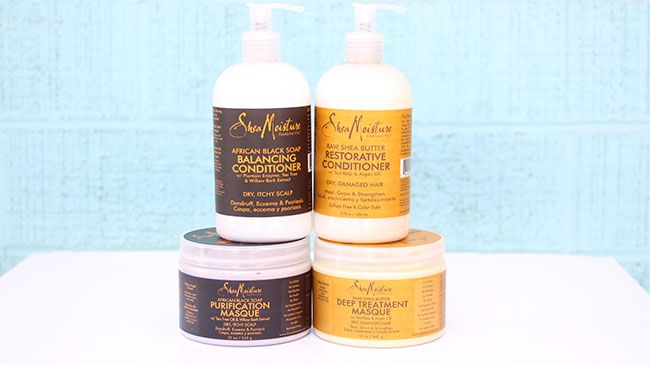
What’s in a daily conditioner?
A daily conditioner is also known as a surface conditioner, cream rinse, or finishing rinse. These are usually formulated to be used in conjunction with a shampoo. They are designed for daily maintenance and manageability for your hair by conditioning the cuticle, making it lie smooth, enhancing shine, and reducing frizz. Manufacturers usually recommend leaving a daily conditioner on the hair for 1-5 minutes before rinsing. The purpose of a daily conditioning rinse is to moderately adsorb ingredients onto the surface of your hair. According to our Curl Chemist Tonya McKay, “adsorption describes the process when atoms or molecules are attracted to the surface of a material (hair”>.”
Manufacturers are careful not to create daily conditioners that will stick to the hair for too long. Daily conditioner formulations are made to last longer than a leave-in treatment, yet shorter than a deep treatment, making it safe and gentle enough for daily usage.
Common Ingredients found in conditioners
ChemistCorner says “for a hair conditioner to work, it has to be left behind. The primary conditioning agents include quaternized surfactants (quats”>, cationic polymers, silicones, emollients, and humectants.” Here are some examples of such ingredients found in conditioners:
Stearalkonium Chloride, Cetrimonium Chloride, Dicetyldimonium Chloride, Behentrimonium Methosulfate, Behentrimonium Chloride, Stearamidopropyl Dimethylamine, Dimethicone, Glycerin, Propylene Glycol, Sodium Lauryl Sulfate, Ammonium Lauryl Sulfate, Cocamidopropyl Betaine, Sodium Lauryl Sulfate, Ammonium Lauryl Sulfate, Cocamidopropyl Betaine, water, to name a few…
Different formulations produce varied effects.
What’s in a deep conditioner?
Deep conditioners are also known as “pack” conditioners. They have a heavy, thick consistency and typically require longer treatment time, which can be anywhere between 10-30 minutes based on manufacturer’s instructions.
The effects of a deep conditioner, like a daily conditioner, include treatment to the surface of the hair. However, most deep conditioners also contain ingredients with low molecular weight. These ingredients penetrate the hair, nourishing between the cuticles, within the cuticle layers and/or within the cortex. Look for formulations with penetrating oils (coconut, avocado, argan, and olive”>, panthenol, hydrolyzed wheat proteins, and caffeine for unprocessed hair- with the cuticle in tact. According to Natural Haven Bloom other ingredients like amino acids, amodimethicone, amino silicones, artificial peptides, 18MEA, and hydrolyzed palm oil, for example can penetrate hair with damaged, extremely porous or chemically treated hair.
The great effects of deep conditioners are longer lasting than a daily conditioner, as deep conditioners have a higher viscosity, which can be measured by “thickness”, and long lasting sustainability. For example, honey has a much higher viscosity than water. The properties can last for weeks at a time before wearing away.
How does length of time impact conditioning levels?
Time does matter, when conditioning. It is best to follow the instructions of the package to know how long to leave your conditioner on your hair. It is in the best interest of the product company to give you the correct time frame. If you are unsure, you cannot go wrong by allowing your rinse out conditioner to sit between 1-5 minutes and your deep conditioner to sit for 30 minutes.
Does conditioning with heat help?
According to Natural Haven Bloom, heat does matter. In a scientific study, the amount of conditioning on the surface of the hair increased beyond the regular 5-10% adsorption rate from start to finish. Grab your processing cap and turn your deep condition up a notch!
So, is there really a difference between the two?
Absolutely! There are similarities and differences. Both conditioners carry a negative cationic charge, and are highly attracted to the positive charge of damaged hair. That being said, deep conditioners have a stronger cationic charge than daily conditioners do.
Both have the ability to attach to the surface of hair for excellent conditioning qualities. However, they are still different. It is important to understand that both conditioners have a place in your hair regimen. The daily conditioner is designed with everyday maintenance in mind and restores excess oils rinsed away with your shampoo, making the hair smooth, detangled, and manageable. The deep conditioner contains long lasting, penetrable ingredients benefitting the strand from the inside out by finding the damaged areas and filling them in order to temporarily rebuild the hair strands.
How to use a daily conditioner and deep conditioner
- Always use a conditioner after cleansing with a shampoo or any cleanser.
- Always follow the directions of the bottle regarding frequency of use, incorporating heat, and length of processing time. Excessive heat or processing times beyond manufacture instructions will not up the ante on your conditioning!
A good starting point for the average curly would be to deep condition no less than once a month. If your hair is oily and very strong you can adjust this. Likewise, women with tighter curl patterns or Type 4 hair can deep condition more often because tighter curl patterns tend to be more porous and dry by nature. So, add this to your current regimen and take advantage of daily and deep conditioning the right way!
How often do you alternate your daily conditioner and deep conditioner? Can you tell the difference?

